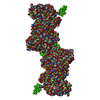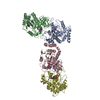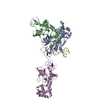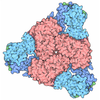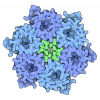[English] 日本語
 Yorodumi
Yorodumi- SASDFM5: Mutant 2-amino-3-carboxymuconate 6-semialdehyde decarboxylase, H1... -
+ Open data
Open data
- Basic information
Basic information
| Entry | Database: SASBDB / ID: SASDFM5 |
|---|---|
 Sample Sample | Mutant 2-amino-3-carboxymuconate 6-semialdehyde decarboxylase, H110A tetramer, at pH 8.5
|
| Function / homology |  Function and homology information Function and homology informationaminocarboxymuconate-semialdehyde decarboxylase / secondary metabolic process / carboxy-lyase activity / hydrolase activity / metal ion binding / cytosol Similarity search - Function |
| Biological species |  Pseudomonas fluorescens (bacteria) Pseudomonas fluorescens (bacteria) |
 Citation Citation |  Journal: J Biol Chem / Year: 2019 Journal: J Biol Chem / Year: 2019Title: Quaternary structure of α-amino-β-carboxymuconate-ϵ-semialdehyde decarboxylase (ACMSD) controls its activity. Authors: Yu Yang / Ian Davis / Tsutomu Matsui / Ivan Rubalcava / Aimin Liu /  Abstract: α-Amino-β-carboxymuconate-ϵ-semialdehyde decarboxylase (ACMSD) plays an important role in l-tryptophan degradation via the kynurenine pathway. ACMSD forms a homodimer and is functionally inactive ...α-Amino-β-carboxymuconate-ϵ-semialdehyde decarboxylase (ACMSD) plays an important role in l-tryptophan degradation via the kynurenine pathway. ACMSD forms a homodimer and is functionally inactive as a monomer because its catalytic assembly requires an arginine residue from a neighboring subunit. However, how the oligomeric state and self-association of ACMSD are controlled in solution remains unexplored. Here, we demonstrate that ACMSD from can self-assemble into homodimer, tetramer, and higher-order structures. Using size-exclusion chromatography coupled with small-angle X-ray scattering (SEC-SAXS) analysis, we investigated the ACMSD tetramer structure, and fitting the SAXS data with X-ray crystal structures of the monomeric component, we could generate a pseudo-atomic structure of the tetramer. This analysis revealed a tetramer model of ACMSD as a head-on dimer of dimers. We observed that the tetramer is catalytically more active than the dimer and is in equilibrium with the monomer and dimer. Substituting a critical residue of the dimer-dimer interface, His-110, altered the tetramer dissociation profile by increasing the higher-order oligomer portion in solution without changing the X-ray crystal structure. ACMSD self-association was affected by pH, ionic strength, and other electrostatic interactions. Alignment of ACMSD sequences revealed that His-110 is highly conserved in a few bacteria that utilize nitrobenzoic acid as a sole source of carbon and energy, suggesting a dedicated functional role of ACMSD's self-assembly into the tetrameric and higher-order structures. These results indicate that the dynamic oligomerization status potentially regulates ACMSD activity and that SEC-SAXS coupled with X-ray crystallography is a powerful tool for studying protein self-association. |
 Contact author Contact author |
|
- Structure visualization
Structure visualization
| Structure viewer | Molecule:  Molmil Molmil Jmol/JSmol Jmol/JSmol |
|---|
- Downloads & links
Downloads & links
-Data source
| SASBDB page |  SASDFM5 SASDFM5 |
|---|
-Related structure data
- External links
External links
| Related items in Molecule of the Month |
|---|
-Models
| Model #2961 |  Type: mix / Radius of dummy atoms: 1.90 A / Chi-square value: 0.250 / P-value: 0.063313  Search similar-shape structures of this assembly by Omokage search (details) Search similar-shape structures of this assembly by Omokage search (details) |
|---|
- Sample
Sample
 Sample Sample | Name: Mutant 2-amino-3-carboxymuconate 6-semialdehyde decarboxylase, H110A tetramer, at pH 8.5 |
|---|---|
| Buffer | Name: 50 mM Tris, 5 mM DTT / pH: 8.5 |
| Entity #1627 | Name: ACMSD / Type: protein Description: 2-amino-3-carboxymuconate 6-semialdehyde decarboxylase Formula weight: 39.661 / Num. of mol.: 4 / Source: Pseudomonas fluorescens / References: UniProt: Q83V25 Sequence: MGHHHHHHHH HHSSGHIEGR HMKKPRIDMH SHFFPRISEQ EAAKFDANHA PWLQVSAKGD TGSIMMGKNN FRPVYQALWD PAFRIEEMDA QGVDVQVTCA TPVMFGYTWE ANKAAQWAER MNDFALEFAA HNPQRIKVLA QVPLQDLDLA CKEASRAVAA GHLGIQIGNH ...Sequence: MGHHHHHHHH HHSSGHIEGR HMKKPRIDMH SHFFPRISEQ EAAKFDANHA PWLQVSAKGD TGSIMMGKNN FRPVYQALWD PAFRIEEMDA QGVDVQVTCA TPVMFGYTWE ANKAAQWAER MNDFALEFAA HNPQRIKVLA QVPLQDLDLA CKEASRAVAA GHLGIQIGNH LGDKDLDDAT LEAFLTHCAN EDIPILVHPW DMMGGQRMKK WMLPWLVAMP AETQLAILSL ILSGAFERIP KSLKICFGHG GGSFAFLLGR VDNAWRHRDI VREDCPRPPS EYVDRFFVDS AVFNPGALEL LVSVMGEDRV MLGSDYPFPL GEQKIGGLVL SSNLGESAKD KIISGNASKF FNINV |
-Experimental information
| Beam | Instrument name: Stanford Synchrotron Radiation Lightsource (SSRL) BL4-2 City: Menlo Park, CA / 国: USA  / Type of source: X-ray synchrotron / Wavelength: 0.1228 Å / Dist. spec. to detc.: 2.5 mm / Type of source: X-ray synchrotron / Wavelength: 0.1228 Å / Dist. spec. to detc.: 2.5 mm | |||||||||||||||||||||||||||||||||
|---|---|---|---|---|---|---|---|---|---|---|---|---|---|---|---|---|---|---|---|---|---|---|---|---|---|---|---|---|---|---|---|---|---|---|
| Detector | Name: Pilatus3 X 1M / Pixsize x: 0.172 mm | |||||||||||||||||||||||||||||||||
| Scan | Measurement date: Jul 15, 2018 / Storage temperature: 25 °C / Cell temperature: 25 °C / Exposure time: 1 sec. / Number of frames: 500 / Unit: 1/A /
| |||||||||||||||||||||||||||||||||
| Distance distribution function P(R) |
| |||||||||||||||||||||||||||||||||
| Result |
|
 Movie
Movie Controller
Controller

